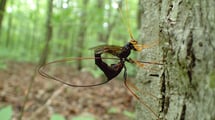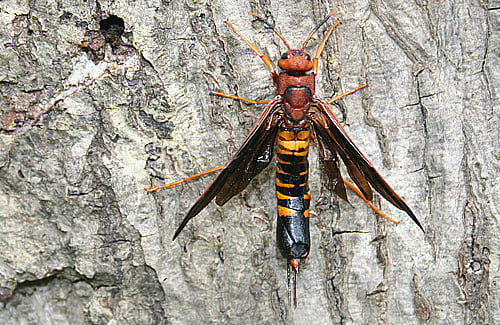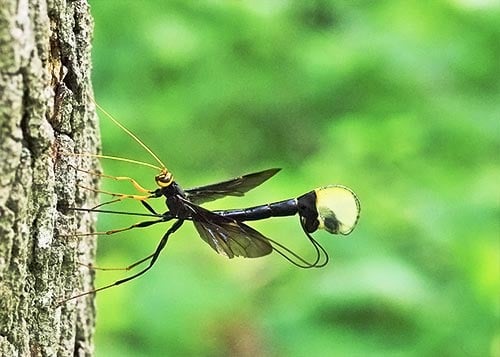Black Giant Ichneumon Wasps in NJ and PA
What are Black Giant Ichneumon Wasps?
Black giant ichneumon wasps are large parasitic insects that can be found across the central and northern United States where tree populations are abundant. The defining characteristic of any giant ichneumon wasp is their 5 inch long ovipositor that most people mistake for a big, intimidating stinger. Black giant ichneumon wasps use this as a tool to insert their eggs into existing pigeon horntail wasp nests that are located within trees. You won't find ichneumon wasps of any kind nesting indoors because they take over existing nests, rather than creating their own with the help of a colony like common stinging insects in our area such as hornets.
Pictured Above: Giant Ichneumon Wasp Photo Credit: University of Wisconsin-Milwaukee
You can easily identify a black giant ichneumon wasp from other flying insects because of their size and coloring. Each wasp is equipped with a long ovipositor, with females having more pronounced than males. Both genders are black with a thin waist that is shorter than the rest of their body. You'll find them resting on trees as they search for a place to lay eggs.
Where do black giant ichneumon wasps come from?
Black giant ichneumon wasps lay eggs on the tree bark, waiting until they sense movement of pigeon horntail wasp larvae as they hatch in their nests created within the tree. Once the female ichneumon wasp detects the presence of pigeon horntail wasps, she inserts her ovipositor into the tree and lays her eggs to feed on pigeon horntail wasp larvae as they grow. 
Pictured Above: Pigeon horntail wasp resting on a tree Photo Credit: BugGuide
This parasitic behavior is part of the natural life cycle of a black giant inchneumon wasp. Eggs are typically laid between June and September. Throughout the winter, the eggs feed on pigeon horntail wasp larvae as they grow. In the following June-September, the adults emerge, lay eggs, and die within 27 days. If you have pigeon horntail wasps on your property, there is a good chance that giant ichneumon wasps will follow.
Do black giant ichneumon wasps sting?
No, black giant ichneumon wasps do not sting. They have no interest in interacting with humans so they do not post a threat to humans or pets. Black giant ichneumon wasps are widely considered to be a beneficial insect for gardeners and homeowners alike. If you find black giant ichneumon wasps resting on the trees in your yard, there is no cause for alarm. The large, thin part of the wasp that looks like a giant intimidating stinger is actually an ovipositor. Ichneumon wasps use this to deposit eggs into pigeon horntail wasp nests below the surface of tree bark.
How can I get rid of black giant ichneumon wasps?
If you find black giant ichneumon wasps on the trees in your yard, it's best that you leave them alone. Black giant ichneumon wasps don't sting humans or pets, cause damage to your home, transmit disease to humans or pets, live in large colonies, or build visible nests around your property. Because these wasps live within trees, there are no visible nests that you can have removed like you can with hornets and wasps. Their life cycle is about 27 days once they reach adulthood and leave their nest. They are barely a nuisance so they don't need to be treated by pest control professionals.
How can Cooper Pest Solutions help?
Unless extreme circumstances exist, Cooper Pest Solutions does not provide black giant ichneumon wasp removal services.


